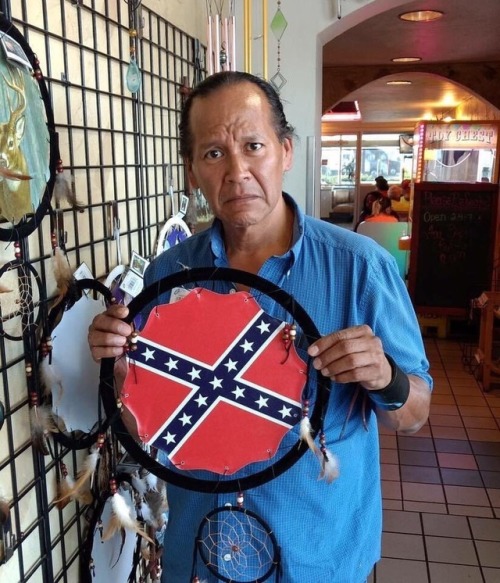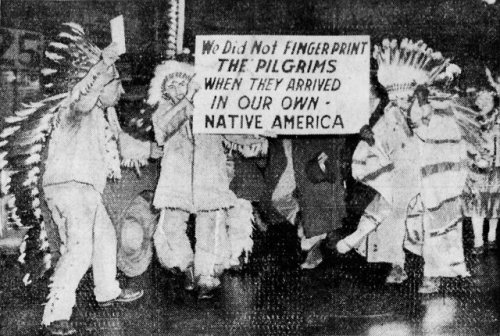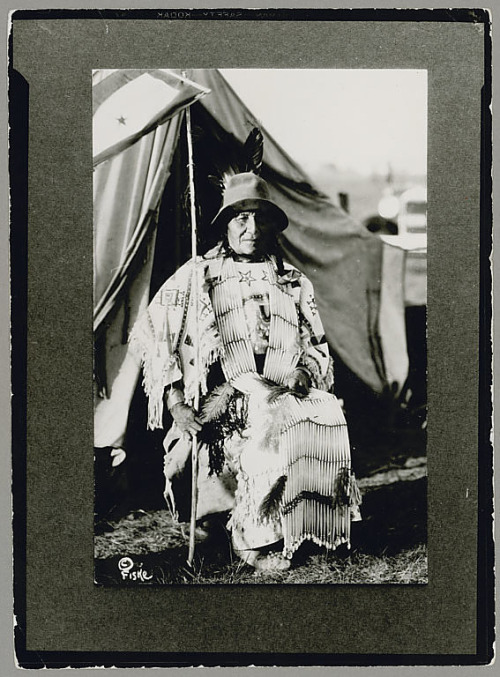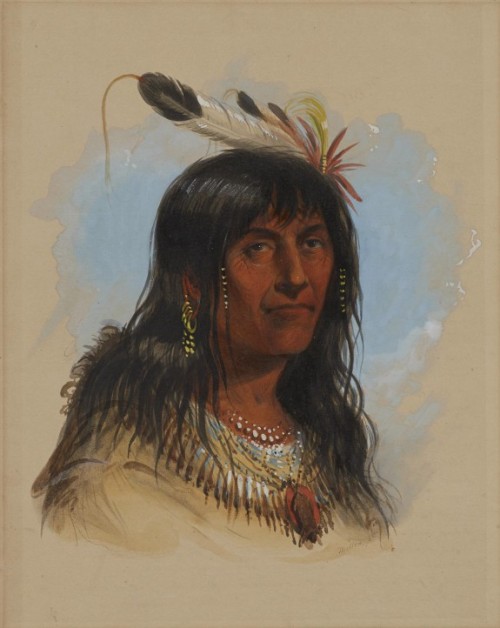#native americans
the fuckery of whiteness…
WHYYYYYYYY….
On behalf of my race, may I just say: we’re a buncha idiots and we should friggin’ know better at this point. Bet me if the maker was asked, she’d spin some line (because fairly sure it’s a she) about ‘catching Southern dreams’ or some nonsense. Argh.
Post link
1940. The US-Canada border was carved right through several pre-existing Native properties, dissecting the tribes of the Iroquois Confederacy. The Indian Defense League staged this protest in 1940, objecting to the US federal classification of First Nations people as foreign aliens.
Post link
Native Arts Grant
First Nations Development Institute (FNDI) established the Native Arts Initiative to stimulate long-term perpetuation, proliferation, and revitalization of artistic and cultural assets in Native communities. Through the Initiative, FNDI awards grants ranging from $15,000 to $32,000 to Native-led nonprofits and tribal government programs that serve Native American artists in the Upper Midwest, Southwest, and Pacific Northwest. Applications are due by 5:00 pm Mountain Time on August 30.
Fresh Tracks brings youth from from urban, rural, and tribal communities together for a three-day expedition, using the outdoors as a background for transformative, cross-cultural leadership development. Youth learn valuable organizing skills, create community action plans, and work with the Center for Native American Youth and partners to make a lasting impact in their home communities. The third of four regional trainings will be held in Indiana from August 10 -12 (including travel dates). Travel, lodging, and meals are covered for participants. Registration is due 12:00 pm Eastern Time on August 3rd.
Nebraska NPR and PBS station is hiring!
NET Office Associate
Provide administrative/operational support to NET including: Radio Manager, News Department, and general administration by scheduling meetings, processing expense invoices, preparing forms, answering phones and correspondence, preparing confidential memos and reports, and maintaining department files. Maintain supplies for the department and manage basic office functions as needed. 30 hours per week.
http://www.netnebraska.org/careers
Black Public Media 360 Incubator
Deadline: Friday, August 31, 2018
Black Public Media (BPM), the nation’s only nonprofit dedicated solely to media content about the black experience, has issued an open call to producers for nonfiction broadcast projects (individual programs or series pilots) and scripted or nonfiction digital web series. The third round of BPM’s 360 Incubator+ will see as many as 10 teams contend for up to $150,000 in funding to help produce the pilots or funding reels of their broadcast or digital projects. The program is designed to get quality programming and content into the pipeline and help move it to market.
https://act.myngp.com/el/E9QQEUyy8mUdmSIuwDC9baMm48GfQODo6gxiB22zfkA=/_dJRqAEkhDnMlPduq2xfRKdnasPdcTUNo_xKSAJF8Ew=
Center for Native American Youth
http://www.cnay.org
Grants here:
First Nations Development Institute
https://firstnations.org
Scholarships here: https://collegefund.org
American Indian College Fund
And if any of you guys are still interested in going to college this Fall, but not sure how or where to start or just want someone to look over your resume or to help you with your application - just message me! Don’t be shy. We all got our start by asking someone a question :)
Pretty Nose - Arapaho war chief
Pretty Nose (b.1851-d.c.1952) was a war chief of the Arapaho people. Her red, black and white beaded cuffs signaled her rank. She distinguished herself by fighting at the Battle of The Little Bighorn in 1876 where the Arapaho, Lakota and Northern Cheyenne defeated the U.S. army.
The above photography was taken at Fort Keogh in 1878. Pretty Nose lived for the rest of her life at a reservation. She was still alive in 1952 and saw her grandson, Mark Soldier Wolf, come back from the Korean War in 1952. By a clear spring morning, Soldier Wolf was reunited with his 101-year-old grandmother. Pretty Nose wore a buckskin dress with elk teeth and her cuffs.
When she saw him, Pretty Nose began to sing a war song. As her grandson later recalled: “It was really something when she sang that song. It didn’t sadden me, just put more strength into me and I wished I could have just stayed there with that song.”(Click here if you want to listen to thesong sung by her grandson).
Warrior women of the Little Bighorn:
References:
Ahtone Tristan, “The story of Soldier Wolf”
Hall Alan R., A Man Called Plenty Horses, The Last Warrior of the Great Plains War
Post link
Moving Robe Woman - Hunkpapa heroine
Moving Robe Woman (1854-1935) was a Hunkpapa Lakota woman who fought during the Battle of the Little Bighorn in 1876 to avenge her brother.
Moving Robe Woman was harvesting turnips when she heard that her brother had been killed by the U.S. cavalry. According to an interview conducted in 1931 she did the following thing:
“I sang a death song for my young brother who had been killed. My heart was bad. Revenge! Revenge! For my brother’s death. (…) I ran to a nearby thicket and got my black horse. I painted my face with crimson and braided my black hair. I was mourning. I was a woman, but I was not afraid.
(…)
By this time the soldiers were forming a battle line in the bottom about a half mile away. In another moment I heard a volley of carbines. The bullets shattered tipi poles. Women and children were running away from the gunfire. In the tumult I heard old men and women singing death songs for their warriors who were now ready to attack the soldiers. The enchanting death songs made me brave, although as was a woman. Father led my horse to me and…we galloped toward the soldiers.”
Warrior Rain in the Face recalled that Moving Robe Woman was “pretty as a bird” as she was galloped on her charger, brandishing her brother’s war staff over her head. He said: “always when there’s a woman in charge it causes the warrior to vie with each other to display their valor”.
Moving Robe Woman fought as fiercely as any of the warriors. She killed two of Custer’s troopers: shooting one with her revolver and stabbing the other to death with her knife. She also reportedly shot the badly wounded interpreter Isaiah Dorman. A possible account tells the scene as follow, with him saying:
““Do not kill me, because I will be dead in a short while, anyway.”
The woman said, “If you did not want to be killed, why did you not stay home where you belong and not come to attack us?” The first time she pointed the gun it did not go off, but the second time it killed him.”
The battle ended in Custer’s death and a temporary victory. Moving Robe Woman died in 1935. She concluded her interview by saying:
“In this narrative, I have not boasted of my conquests. I am a woman, but I fought for my people. The white man will never understand the Indian. Eyas Hen La! I have said everything!”
Warrior women of the Little Bighorn:
Bibliography:
“Eagle Elk’s story of the battle of the Little Bighorn”
Hall Alan R., A Man Called Plenty Horses, The Last Warrior of the Great Plains War
Hardoff Richard G., Lakota Recollections of the Custer Fight, New Sources of Indian-military History
Lawson Michael L., Little Bighorn, Winning the Battle, Losing the War
Philbrick Nathaniel, The Last Stand, Custer, Sitting Bull and the Battle of the Little Bighorn
Post link
Minnie Hollow Wood and One Who Walks With the Stars - Lakota warriors
Minnie Hollow Wood (c.1856-1930′s) was a Lakota woman and wife to chief Hollow Wood. In 1876, she fought at the battle of Little Bighorn, which ended in a victory of the native tribes against the U.S. army. Minnie distinguished herself when fighting against the U.S. cavalry and was awarded the right to wear a war bonnet.
The tide later turned, and she and her husband surrendered to general Nelson Miles. In 1877, she was among the prisoners at Fort Keogh. She and her husband were later transferred to a reservation where they lived the rest of their lives. The above photograph was taken in 1930 when Minnie Hollow Wood was 74.
Oglala Lakotawoman One Who Walks With the Stars also resisted Custer’s soldiers. She was the wife of Brulé Lakota (or possibly an Oglala) chief Crow Dog. Her story was preserved by survivors of the fight. While her husband didn’t kill anyone during the battle, she killed two soldiers who tried to swim across the river.
Warrior women of Little Big Horn:
Bibliography:
Hirschfeld Arlene, Paulette F. Molin, The Extraordinary Book of Native American Lists
Lawson Michael L., Little Bighorn Winning the Battle, Losing the War
Liberty Margot,”Cheyenne Primacy: The Tribes’ Perspective As Opposed To That Of The United States Army; A Possible Alternative To “The Great Sioux War Of 1876″
Miller Humphrey David, Custer’s fall
Wakim Dennis Yvonne, Native American Almanac More Than 50,000 Years of the Cultures and Histories of Indigenous Peoples
Post link
Nanye’hi “Nancy” Ward - Beloved woman of the Cherokee
Nanye’hi (1738-1822) was a woman the Cherokee nation. In the early 1750s she married a man named Kingfisher. In 1755, she went with him on a military expedition against the neighboring Creeks. Women went with war parties to draw water, gather firewood and cook since male warriors weren’t supposed to perform these tasks due to the separation of gender roles.
During a battle, Nanye’hi hid behind a log, but her husband was shot and killed. She took his gun and fought on, leading the Cherokee to victory. Though war was technically a male domain, there were still instances of Cherokee women taking arms. During the American Revolution, a Cherokee woman “painted and stripped like a warrior and armed with bows and arrows” was found dead on the battlefield. During the same period, another woman slew her husband’s killer on the battlefield and was allowed to join the warriors in the war dance carrying her gun and tomahawk.
In the early 19th century, missionary John Gambold met an old woman named Chicouhla who had “gone to war against hostile Indians and suffered several wounds”. A woman namedCuhtahlatahrallied the warriors after her husband was killed in defending the village. She took his tomahawk, shouted “Kill, kill!” and lead her people to victory. In the 1880s a Cherokee woman whose name meant” “Sharp Warrior” was active.
Nanye’hi was rewarded for her heroism and granted the title of Agigaue,which translates as “Beloved Woman” or “War Woman”. There was, for instance, a “War Woman’s creek”, commemorating the stratagem of a woman who had led her people to victory and was after rewarded with a chiefly position.
Women like Nanye’hi were indeed influential and powerful. Their words were listened to and they were the head of the Women’s Council, involving representatives from each clan. Nanye’hi could also seat at the council of Chiefs. Agigaue also participated in martial dances and prepared the “Black Drink” that was given to the warriors who were about to go on the warpath. She had a right to spare prisoners who had been sentenced to death and in 1776 saved a white woman named Mrs. Bean. In 1781, she and other women helped five traders to escape to safety.
In the late 1750′s, Nanye’hi married white traded Bryant Ward and anglicized her name as Nancy. They had a daughter together named Elizabeth. Before 1760, he returned to live with his other family and Elizabeth remained with her mother. Nanye’hi didn’t, however, completely sever ties with him and sometimes visited him.
During the American Revolution, Nanye’hi sided with the new United States, a rare position among the Cherokee. In 1776, she warned settlers of an impending Cherokee attack. It seems that her decisions came from pragmatism, as she was aware of the superiority of the settler’s superiority in numbers and weapons. In October 1776 Colonel William Christian led a devastating raid on Cherokee territory, but spared Nanye’hi’s town of Chote out of respect for her. Chote was nonetheless destroyed in 1781, Nanye’hi was taken into custody, but was later allowed to leave to rebuild the town.
In 1781, Nanye’hi appeared at her a treaty conference with United States commissioners held on the Long Island. There had been cases before her of Cherokee women serving as ambassadors. She said:
“You know that women are always looked upon as nothing; but we are our mothers and you are our sons. Our cry is all for peace; let it continue. This peace must last forever. Let your women’s sons be ours; our sons be yours. Let your women hear our words.”
Her plight was heard. The original demands were revised and the Cherokee only had to give their land north of the Nolichucky River instead of giving all their lands north of the Little Tennessee River. She called for peace again in 1785, but this time the Cherokee had to cede more lands.
In the 19th century, the Cherokee government system was changing and there was less and less place for a woman like the aging Nanye’hi. United States agents who tried to “civilize” the Cherokee by imposing their values and the statues of women in the nation began to decline. In 1819, her town was ceded and she had to leave with her retinue for the Ocoee River near the present town of Benton, where she ran a sort of inn for travelers. She died in 1822. She thus didn’t live to see her people’s exile on the Trail of Tears following the Indian Removal Act in 1830.
Bibliography:
Harris McClary Ben, “Nancy Ward: The Last Beloved Woman of the Cherokees”
Perdue Theda, “Nancy Ward”, in: Glinton Catherine G. (ed.), Portraits of American Women from Settlement to the Present
Post link
One of the more unusual magics passed down through Native traditions is that of basket weaving - more specifically, the art of weaving magic into a basket as one weaves it by hand. Though many cultures across the world had histories of basketmaking, none in the world, either mundane or magical, could compare with those skills passed down by the tribes of California.
The beauty and utility of the baskets produced by magical and non-magical hands alike were such that the Native peoples had no need to make the change to pottery as their more southern kin did, and European-descended wix often had hard trouble telling where the craftsmanship ended and the magic began. Even unenchanted baskets could be woven tightly enough to hold boiling water, and enchantments have been reported to vary as widely as the baskets they were woven into.
The tradition was nearly lost due to the decimation of both the tribes and the plants with which they made their baskets, thanks to disease and the desecration of the land by Spanish and later American settlers. By the time La Academia Occidental opened its doors, many tribes’ techniques had been lost, in part or in full, and the remainder struggled together to piece together traditions torn apart over the decades by the families of the children they now learned beside.
In the early 1990s, efforts were made by a statewide gathering of people, both Native and otherwise, to revive and restore the ancient practice in full. Through providing a healthy environment for both weaver and plant, as well as increasing the protected territories of both, a resurgence has brought the art back into popular awareness. Now, anyone with money to spend can get themselves a basket enchanted with anything preserving charms to feather-light charms to charms promoting good health, though the secrets behind the magic itself still remains firmly among those willing to dedicate themselves to the art and the cause.
[Image Source: CIBA.org]
Post link
Tribes Were Supposed To Get $8 Billion In COVID-19 Aid. They’ve Gotten $0.
Tribes Were Supposed To Get $8 Billion In COVID-19 Aid. They’ve Gotten $0.
The delay in disbursing the money “is unnecessary and works against the federal government’s trust responsibility,” House Democrats told Treasury.
Tribal governments were supposed to get $8 billion in direct emergency relief from the CARES Act, the $2 trillion COVID-19 stimulus bill that became law on March 27.
More than a month later, they haven’t gotten any of it.
Part of the reason is that the Treasury Department, which is charged with distributing that money, has been flailing in its dealings with tribes.
Another reason stems from a lawsuit over whether Alaska Native Corporations are entitled to the money. A federal court on Monday agreed to stop funds from going to those corporations for now, which means Treasury has no reason to not funnel money immediately to the 574 federally recognized tribal governments struggling with the public health and economic fallout from the coronavirus pandemic.
Big Bowl (A Crow Chief) - Alfred Jacob Miller, c. 1858
Watercolor heightened with white on paper, H: 11 15/16 x W: 9 ½ in. (30.3 x 24.1 cm)
“This [Big Bowl] is a translation from the Indian name by the interpreter, who signified to him that we preferred his profile instead of front view of his face; - to this he objected, we wished to learn the reason, and after some delay, he said that if I had only one side of his face, in case he was in battle, I might have the power of making that side sick; - evidently looking on me as a species of magician. The reasoning was not very satisfactory, but he was determined to have his own way, a three-quarter view was the result.” A.J. Miller, extracted from “The West of Alfred Jacob Miller” (1837). In July 1858 William T. Walters commissioned 200 watercolors at twelve dollars apiece from Baltimore born artist Alfred Jacob Miller. These paintings were each accompanied by a descriptive text, and were delivered in installments over the next twenty-one months and ultimately were bound in three albums. Transcriptions of field-sketches drawn during the 1837 expedition that Miller had undertaken to the annual fur-trader’s rendezvous in the Green River Valley (in what is now western Wyoming), these watercolors are a unique record of the closing years of the western fur trade. [x]
Post link









